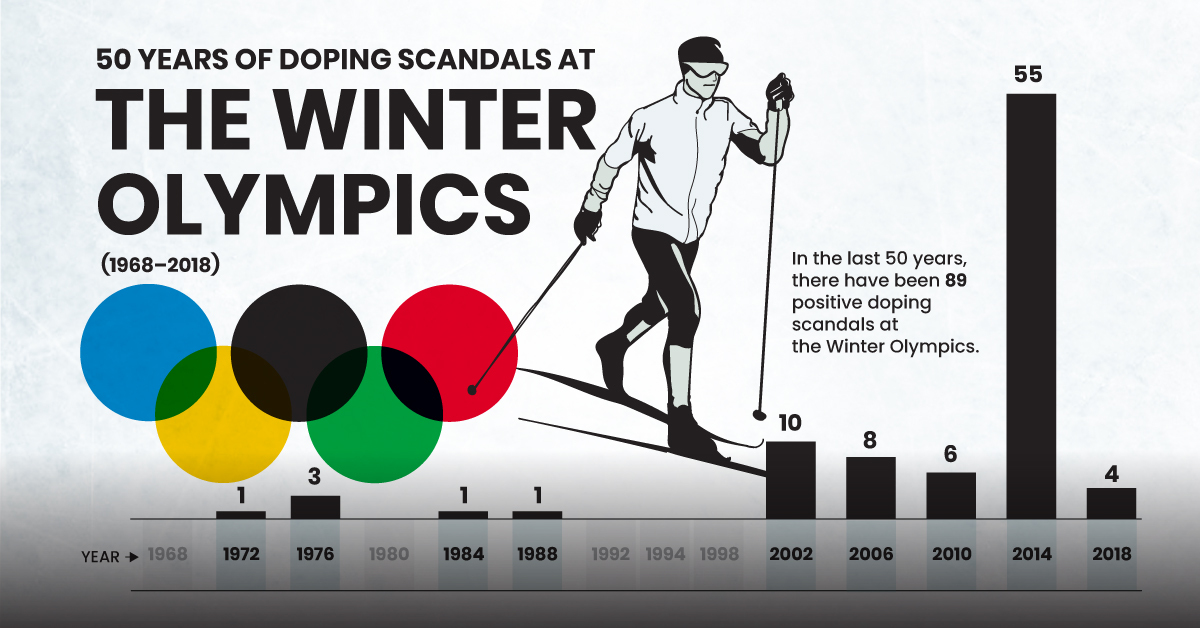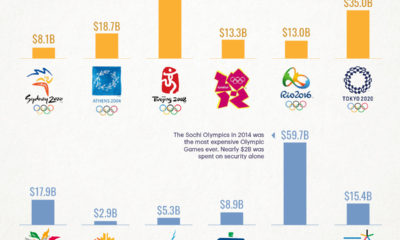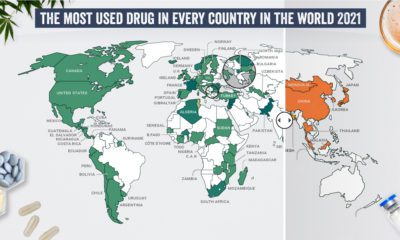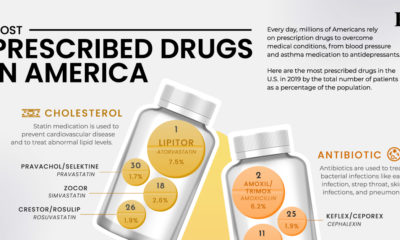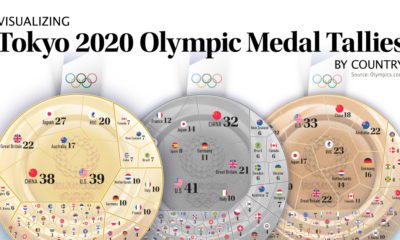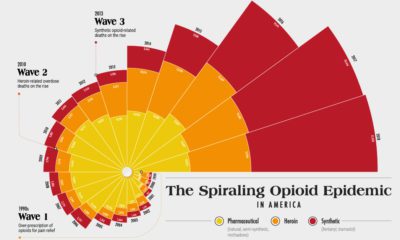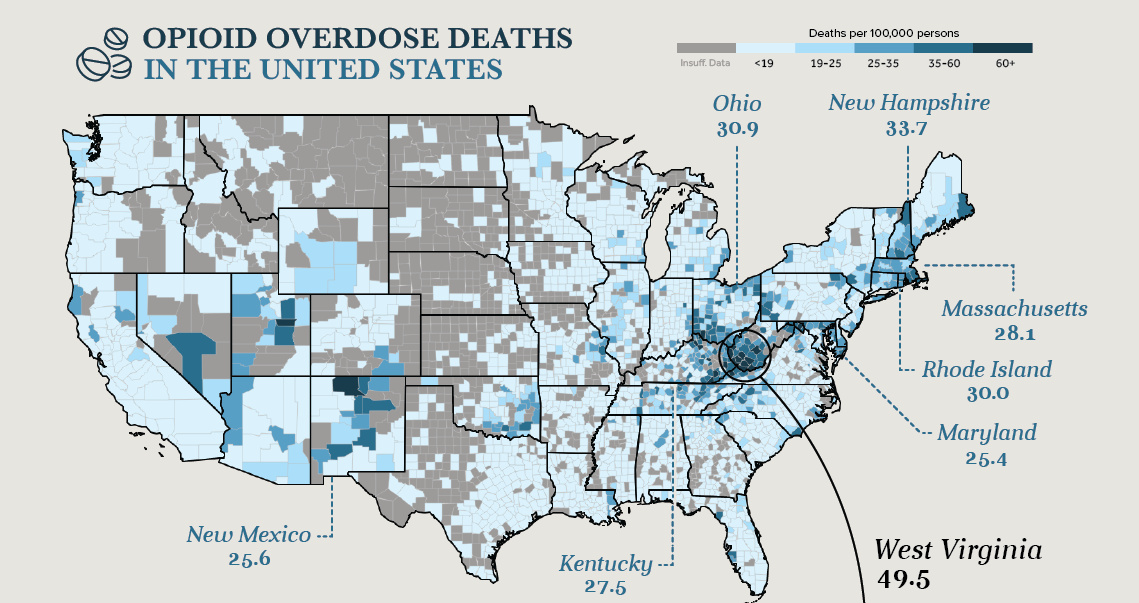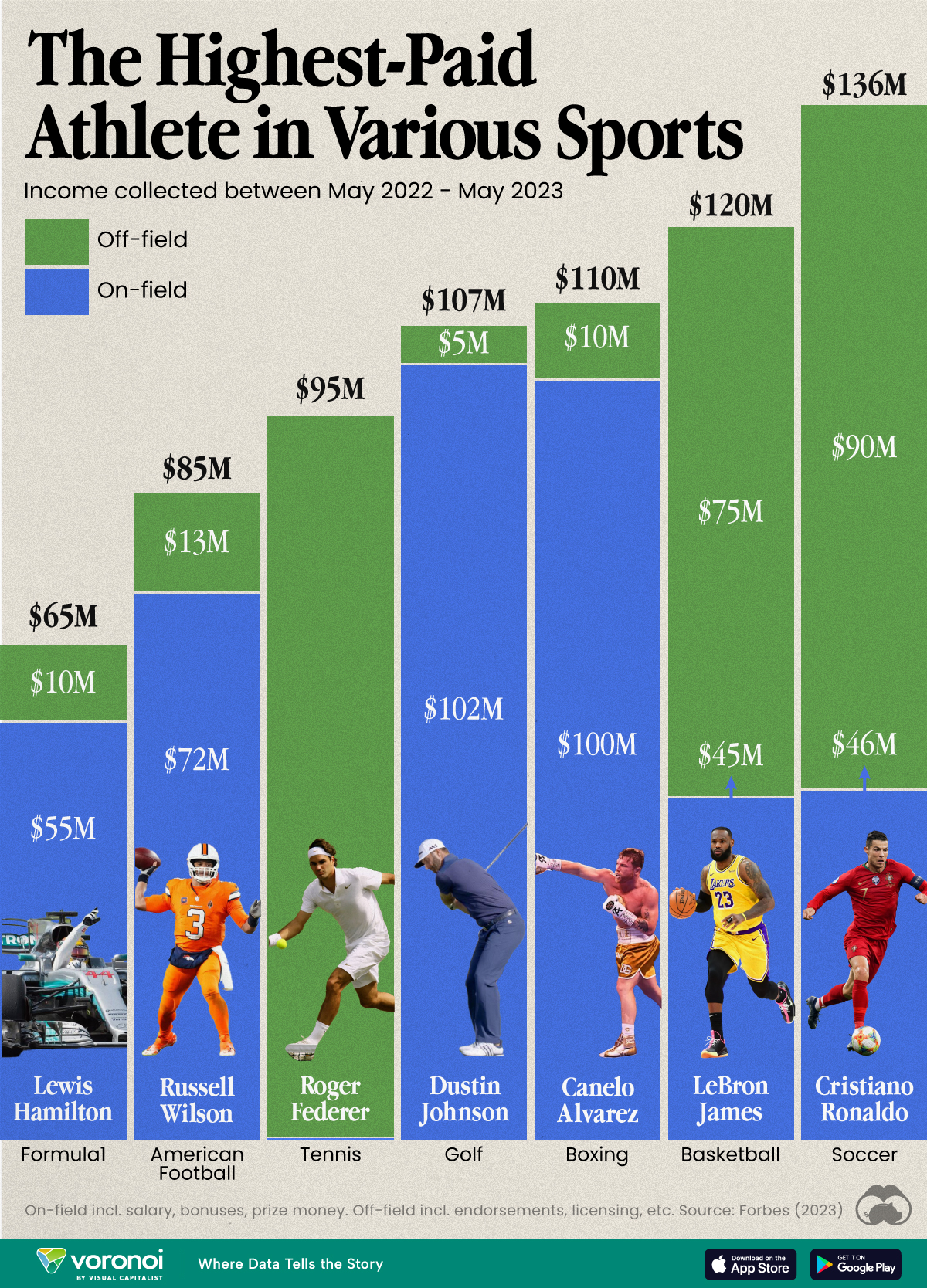Sports
Visualizing 50 Years of Doping Scandals at the Winter Olympics
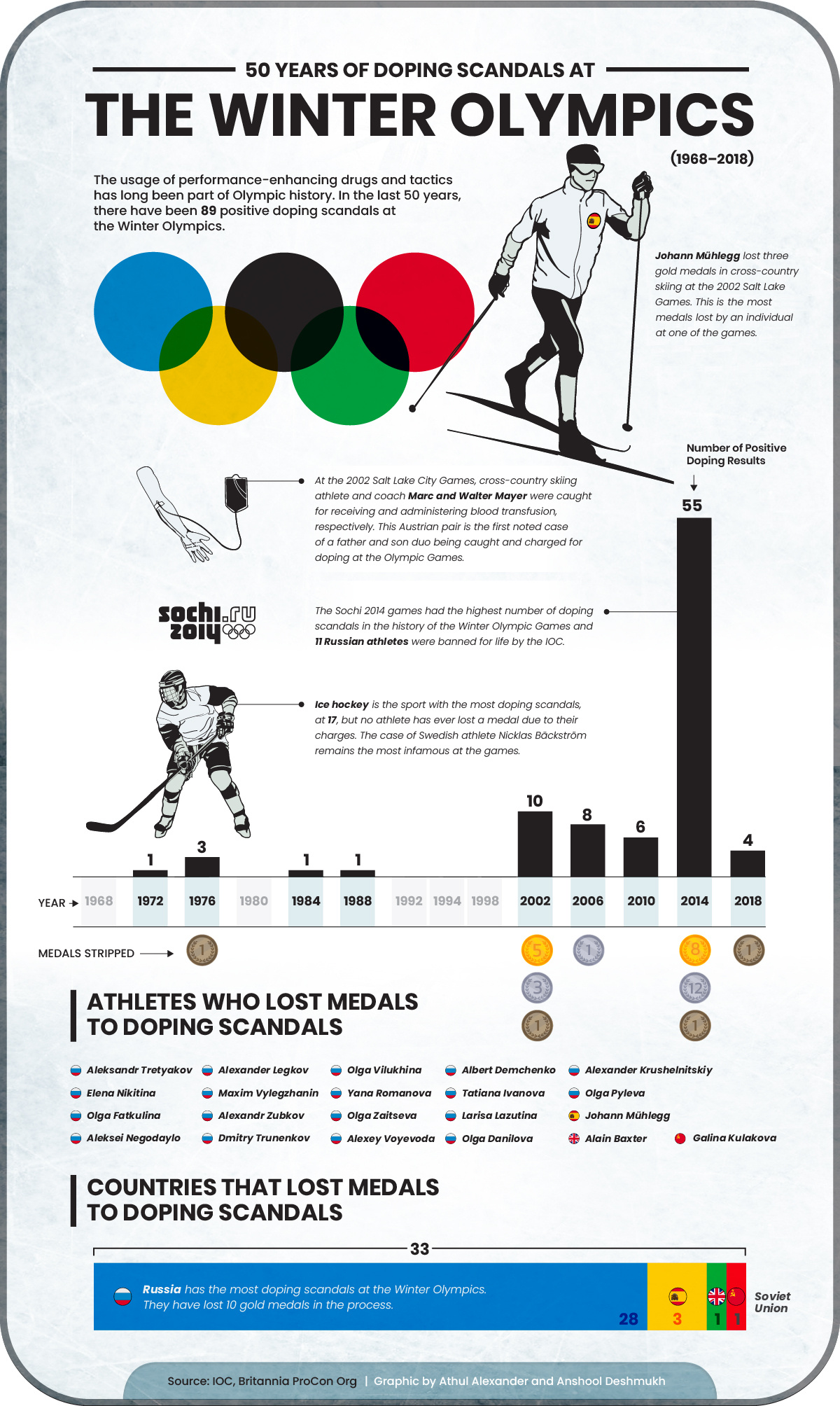
Doping Scandals at the Winter Olympics
The Winter Olympics has had its fair share of scandals, from individual Olympians being barred from competition to elaborate state-run doping conspiracies.
Since drug testing began at the Olympics in 1968, there have been 89 positive doping cases at the Winter Olympics.
With the help of data collected and presented by the International Olympic Committee (IOC) and Procon.org, the above infographic created by Athul Alexander looks at all the doping scandals at the Winter Olympics from the past 50 years.
How it Began: A History of Doping at the Games
The first doping case at the Winter Olympics was noted at the 1972 Sapporo Games, when West German ice hockey player Alois Schloder tested positive for the banned substance ephedrine. He was eventually cleared of all his charges, and his suspension was lifted.
| Year | Olympic Games | # of Positive Doping Cases | # of Medals Lost |
|---|---|---|---|
| 1972 | Sapporo | 1 | 0 |
| 1976 | Innsbruck | 3 | 1 |
| 1980 | Lake Placid | 0 | 0 |
| 1984 | Sarajevo | 1 | 0 |
| 1988 | Calgary | 1 | 0 |
| 1992 | Albertville | 0 | 0 |
| 1994 | Lillehammer | 0 | 0 |
| 1998 | Nagano | 0 | 0 |
| 2002 | Salt Lake City | 10 | 9 |
| 2006 | Turin | 8 | 1 |
| 2010 | Vancouver | 6 | 0 |
| 2014 | Sochi | 55 | 21 |
| 2018 | Pyeongchang | 4 | 1 |
| Total | 89 | 33 |
Doping scandals have accelerated in the modern era, with only six positive cases occurring in the first 30 years of the Winter Olympics.
Heightened drug testing, beginning with the 2002 Winter Olympics, has since seen the number of positive cases rise dramatically.
Notable Games Marred by Doping Scandals
Many of the Olympic Winter Games have been engulfed in doping scandals, including:
Nagano, 1998
The first-ever gold medal in Olympic snowboarding went to Canadian Ross Rebagliati. He was stripped of his medal after failing a marijuana drug test, which at the time was a banned substance. However, the Court of Arbitration for Sport later overruled this decision.
This was the first case of athletes being stripped of medals due to their use of cannabis, which has since gone through a swath of legalization and has been taken off the list of banned substances by the World Anti-Doping Agency.
Salt Lake City, 2002
As many as 100 drugs tests showed traces of the banned performance-enhancing drug erythropoietin (EPO). This was the first instance where all endurance athletes were tested for EPO during the games.
Skiing was hit the hardest with nine of the 10 positive doping cases coming from the sport.
To make matters worse, cross-country skier Johann Mühlegg, who had just won three gold medals at the games, tested positive for a performance-enhancing substance, darbepoetin. He was eventually stripped of all his medals from the games.
Turin, 2006
Six Austrian athletes were banned for life from the Olympics for their involvement in a doping scandal at the games. This was the first time the IOC punished athletes without a positive or missed doping test.
The Austrians were found guilty of possessing doping substances and taking part in a doping conspiracy. The Italian police found materials during a raid on the athletes’ living quarters. The Austrians also had their competition results annulled.
Sochi, 2014
Dozens of Russian athletes at the 2014 Winter Olympics in Sochi, including at least 15 medal winners, were part of a state-run doping program, meticulously planned for years to ensure dominance at the games.
The most notable involvement in the scandal came from 14 members of Russia’s cross-country ski team and two veteran bobsledders, who won two golds. The IOC later banned 11 Russian athletes for life for their involvement.
Sochi had the most doping cases in the Winter Olympics history, with 55 total cases and 21 medals stripped from various athletes.
Pyeongchang, 2018
The entire Russian contingent was banned from participating due to their involvement in the state-run doping scandal at the Sochi games. Some Russian athletes, who were deemed clean, were still allowed to participate under the banner of Olympic Athletes from Russia (OAR).
This unprecedented ban still had critics crying foul, saying the punishment wasn’t strict enough. They didn’t believe the ban would deter officials and athletes from performing the same tactics in the future.
Despite the strict scrutiny on the Olympic Athletes from Russia, two athletes were still caught using performing-enhancing drugs. This included curler Alexander Krushelnitskiy, who lost his bronze medal in the process.

This article was published as a part of Visual Capitalist's Creator Program, which features data-driven visuals from some of our favorite Creators around the world.
Culture
The Highest Earning Athletes in Seven Professional Sports
We illustrate how much the highest earning athletes across seven different sports make, and where they get their money from.
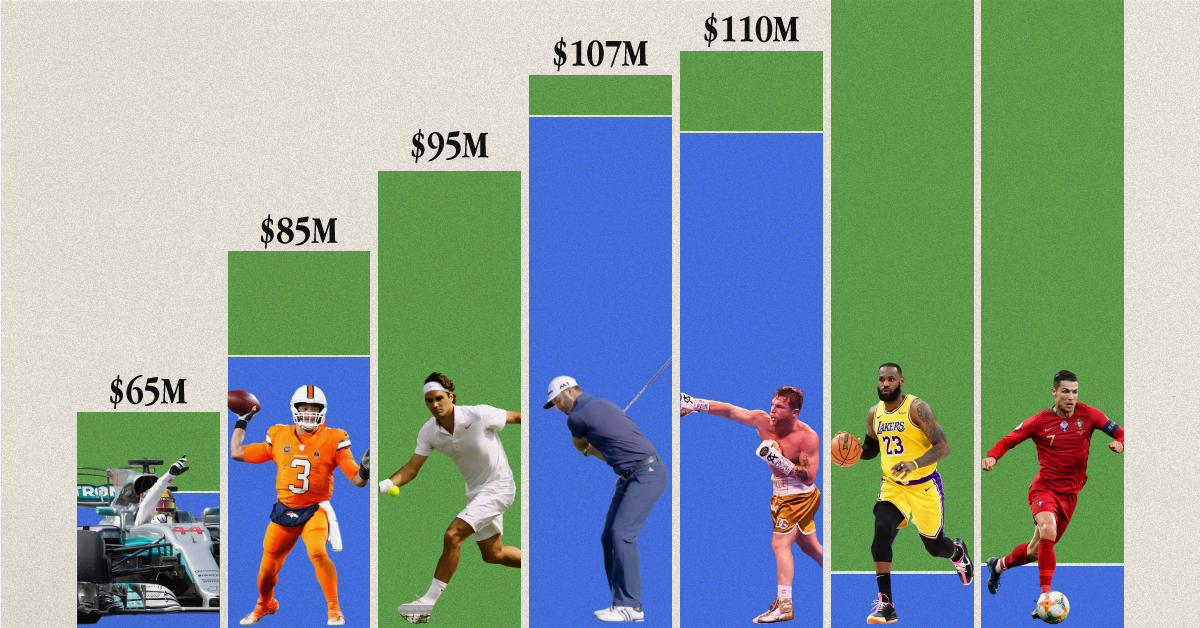
The Highest Earning Athletes in Seven Professional Sports
This was originally posted on our Voronoi app. Download the app for free on Apple or Android and discover incredible data-driven charts from a variety of trusted sources.
How much money do the world’s biggest athletes really make? And how do they compare across different sports?
We visualized the highest earning athletes in various professional sports, according to calculations from Forbes. Earnings reported here cover the period of May 2022 to May 2023. Earnings includes on-field (salary, bonuses, prize money) and off-field (endorsements, licensing, etc).
Forbes’ research included talking to industry insiders, following news reports, and parsing salary databases. Please see their methodology page for further details.
Who is the Highest Paid Athlete in the World?
Cristiano Ronaldo was the highest-paid athlete in the world, making an estimated $136 million between May 2022 and May 2023. His move to Saudi Arabian club Al Nassr set a record for the biggest contract in the sport at the time.
Here’s how he compared to the top earners in some other sports.
| Athlete | Sport | Total Earnings (May 2022–23) |
|---|---|---|
| Cristiano Ronaldo | ⚽ Soccer | $136M |
| LeBron James | 🏀 Basketball | $120M |
| Canelo Alvarez | 🥊 Boxing | $110M |
| Dustin Johnson | ⛳ Golf | $107M |
| Roger Federer | 🎾 Tennis | $95M |
| Russell Wilson | 🏈 American Football | $85M |
| Lewis Hamilton | 🏎️ Formula 1 | $65M |
Note: Figures are rounded.
Los Angeles Lakers superstar LeBron James made the most money in basketball (just under $120 million), which is almost twice as much as Formula 1’s top earner, Lewis Hamilton, who took home about $65 million in 2022–23.
Something else to note is how off-court earnings can contribute significantly to total income for some athletes.
| Athlete | Sport | On-Field Earnings | Off-Field Earnings |
|---|---|---|---|
| Cristiano Ronaldo | ⚽ Soccer | $46M | $90M |
| LeBron James | 🏀 Basketball | $45M | $75M |
| Canelo Alvarez | 🥊 Boxing | $100M | $10M |
| Dustin Johnson | ⛳ Golf | $102M | $5M |
| Roger Federer | 🎾 Tennis | $0.1M | $95M |
| Russell Wilson | 🏈 American Football | $72M | $13M |
| Lewis Hamilton | 🏎️ Formula 1 | $55M | $10M |
Note: Figures are rounded.
This is most apparent with Roger Federer, who retired in 2022, after playing his last Laver Cup. However, his massive deals with Uniqlo, Rolex, and Mercedes, as well as his stake in running company On, still keeps him towards the top of the these lists.
Together with Ronaldo and James, these three athletes are widely considered the face of their sport, undoubtedly helping them secure lucrative endorsements and business deals.
-

 Green7 days ago
Green7 days agoThe Carbon Footprint of Major Travel Methods
-

 Debt2 weeks ago
Debt2 weeks agoHow Debt-to-GDP Ratios Have Changed Since 2000
-

 Culture2 weeks ago
Culture2 weeks agoThe Highest Earning Athletes in Seven Professional Sports
-

 Science2 weeks ago
Science2 weeks agoVisualizing the Average Lifespans of Mammals
-

 Brands2 weeks ago
Brands2 weeks agoHow Tech Logos Have Evolved Over Time
-

 Energy2 weeks ago
Energy2 weeks agoRanked: The Top 10 EV Battery Manufacturers in 2023
-

 Demographics2 weeks ago
Demographics2 weeks agoCountries With the Largest Happiness Gains Since 2010
-

 VC+2 weeks ago
VC+2 weeks agoVC+: Get Our Key Takeaways From the IMF’s World Economic Outlook

